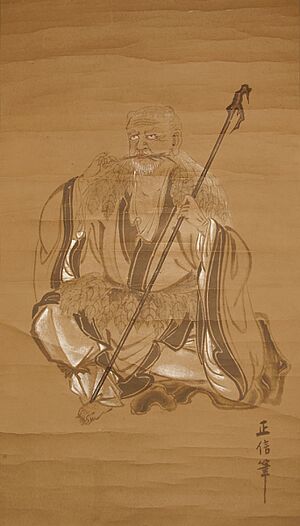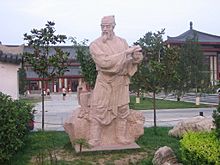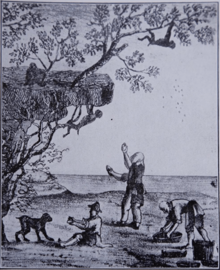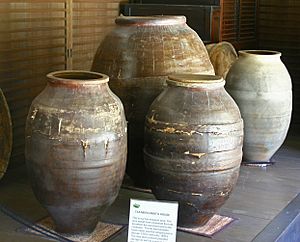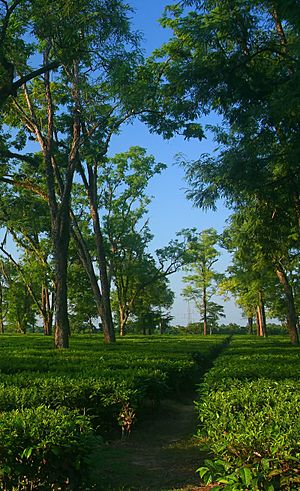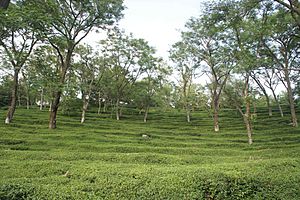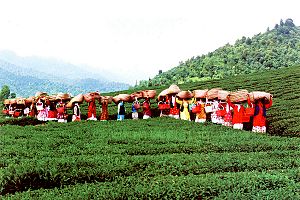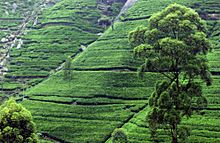History of tea facts for kids
The story of tea goes back thousands of years and spans many different cultures. The tea plant, called Camellia sinensis, comes from East Asia, likely from the border areas of southwestern China and northern Burma. People in China's Shang Dynasty were drinking tea as a medicine a very long time ago. One of the first clear records of tea drinking is from a medical book written by Chinese doctor Hua Tuo in the 3rd century AD.
Tea became known to the Western world through Portuguese priests and traders in China in the early 1500s. It became very popular in Britain in the 1600s. The British then started growing tea in British India to compete with China, which had a monopoly on tea production.
Contents
Where Did Tea Come From?
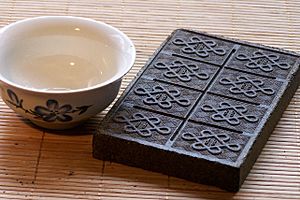
The tea plant, Camellia sinensis, first grew in a special area where southwest China, Tibet, northern Burma, and northeast India meet. From this one spot, the plant was taken to over 52 other countries around the world.
For a long time, scientists thought there were two different origins for tea plants because of small differences between the Assam and Chinese types. However, studies show that all tea plants have the same number of chromosomes and can easily mix. This suggests that all tea came from one place: the Yunnan and Sichuan provinces in China, and northern Burma.
Yunnan Province is often called "the birthplace of tea." It's believed to be the first place where people discovered that eating tea leaves or making a drink from them could be enjoyable. In Fengqing County in Yunnan, there's even a tea tree said to be the oldest cultivated one in the world, about 3,200 years old!
According to the book The Story of Tea, people in Yunnan province likely started drinking tea during the Shang Dynasty (around 1500–1046 BC) as a medicine. From there, it spread to Sichuan. In Sichuan, people started boiling tea leaves by themselves to make a strong liquid, without adding other herbs. This made tea a bitter but energizing drink, not just a medicine.
Experts think that tea drinking probably began in southwest China. They also believe that the Chinese words for tea might have come from the Austroasiatic languages spoken by the people who lived in that area long ago.
Fun Legends About Tea's Start
Many cultures have interesting stories about how tea was discovered. Here are a couple of popular ones:
The Chinese Emperor's Discovery
One famous Chinese legend says that Shennong, an ancient Chinese Emperor, was drinking a bowl of boiled water. This was around 2737 BC, because he had ordered everyone to boil their water for safety. Suddenly, some leaves from a nearby tree blew into his water. The water changed color and taste. The emperor tried a sip and was surprised by how good it tasted and how it made him feel better.
Another version of this story says that Emperor Shennong used to test different herbs on himself to learn about their medical uses. Some of these herbs were poisonous. He found that tea worked as an antidote, helping him recover from the poisons. Shennong is also mentioned in The Classic of Tea, a famous old book about tea by Lu Yu.
The Monk's Eyelids
Another legend comes from the Tang Dynasty. It tells of Bodhidharma, who started Chan Buddhism. He was meditating in front of a wall for nine years and accidentally fell asleep. He was so upset with himself for being weak that he cut off his eyelids. When his eyelids fell to the ground, they took root and grew into tea bushes! A similar story replaces Bodhidharma with Gautama Buddha.
Tea's Early History
Tea in Ancient China
The Chinese have been drinking tea for thousands of years. The oldest physical proof, found in 2016, came from the tomb of Emperor Jing of Han in Xi'an. This shows that emperors were drinking tea as early as the 2nd century BC. Scientists identified the samples as tea using special tests. Old writings suggest tea might have been drunk even earlier. People in the Han dynasty used tea as medicine, though we don't know when they first used it as a stimulant.
China is believed to have the earliest records of tea use, possibly going back to the 10th century BC. The word for tea in Chinese today only came into use in the 8th century AD. So, it's not always clear if older words like tu (荼) referred to tea or other bitter plants. However, it was recorded that the Ba people in Sichuan gave tu to the Zhou dynasty king. A scholar from the 1600s, Gu Yanwu, wrote that "It was after the Qin had taken Shu that they learned how to drink tea."
The first known mention of boiling tea comes from a Han dynasty book called "The Contract for a Youth" by Wang Bao. It lists tasks for a young helper, including "he shall boil tea and fill the utensils." The first record of growing tea also dates to this time, on Meng Mountain near Chengdu. From the Tang Dynasty to the Qing dynasty, the first 360 tea leaves picked there each spring were given to the emperor. Even today, the green and yellow teas from this mountain are highly valued.
A reliable record of tea drinking from 220 AD is in a medical book by Hua Tuo. He wrote that "to drink bitter t'u constantly makes one think better." Before the mid-8th century Tang dynasty, tea drinking was mostly a practice in southern China. It became very popular during the Tang dynasty and spread to Korea, Japan, and Vietnam.
Laozi, a famous Chinese philosopher, supposedly called tea "the froth of the liquid jade." He said it was a key part of the "elixir of life." Legend says that Laozi was sad about society's problems and left for the west. On his journey, a customs officer offered him tea and asked him to write down his wisdom. This became the Tao Te Ching.
Lu Yu's book, The Classic of Tea, from the Tang dynasty, is an important early work on tea. It says tea drinking was widespread. The book explains how tea plants were grown, how leaves were processed, and how tea was made into a drink. It also talked about how to judge tea quality and where the best tea leaves came from. Teas from this time were mainly tea bricks, often used as money, especially far from the empire's center. Back then, tea leaves were steamed, then pounded and shaped into cakes or bricks.
During the Song Dynasty, how tea was made and prepared changed. Many loose-leaf teas appeared, which helped keep the delicate flavors liked by the royal court. This is where today's loose teas and the practice of brewing tea come from. Powdered tea also became popular. For centuries, steaming tea leaves was the main way to prepare tea. After the change from compressed tea to powdered tea, how tea was made for trade changed again.
In the mid-1200s, the Chinese learned a new way to process tea. Tea leaves were roasted and crumbled instead of steamed. By the Yuan dynasty and Ming dynasty, unfermented tea leaves were first pan-fried, then rolled and dried. This stops the leaves from turning dark and keeps them green. In the 1400s, oolong tea was created. For oolong, tea leaves were partly fermented before pan-frying. Westerners, however, preferred fully oxidized black tea, so leaves were allowed to ferment even more. Yellow tea was accidentally discovered during green tea production in the Ming dynasty. If leaves were left out a bit too long, they turned yellow, creating a new flavor.
Historically, making tea in China was hard work, often done in remote areas. This led to many interesting stories about harvesting tea. For example, one legend says that monkeys picked tea. Villagers would tease the monkeys, who would get angry and throw handfuls of tea leaves at them. Some products today claim to be "monkey picked tea," but most experts doubt this ever happened. For hundreds of years, tea plants have been more like bushes than trees. "Monkey picked tea" is probably just a name for certain types of tea.
In 1391, the Hongwu Emperor ordered that only loose tea would be accepted as a "tribute" (a gift to the emperor). Because of this, tea production switched from cake tea to loose-leaf tea. New ways of processing tea developed, like pan-firing and sun-drying, which used less energy. By the end of the 1500s, loose-leaf tea had completely replaced the older tradition of cake and powdered tea.
Tea in Japan
During China's Sui dynasty, Buddhist monks brought tea to Japan. Tea use spread in Japan during the 6th century AD. When Japanese priests and envoys went to China to learn about its culture, they brought tea back to Japan, making it a drink for religious people. Records show that the first tea seeds were brought by a priest named Saichō in 805 and another named Kūkai in 806. Tea became a drink for royalty when Emperor Saga encouraged growing tea plants. Seeds were imported from China, and tea farming began in Japan.
In 1191, Zen priest Eisai brought tea seeds to Kyoto. Some of these seeds were given to priest Myoe Shonin and became the basis for Uji tea, a famous type of Japanese tea. Eisai also wrote the oldest tea book in Japan, Kissa Yōjōki (How to Stay Healthy by Drinking Tea). He wrote this two-volume book in 1211 after his last visit to China. The first sentence says, "Tea is the ultimate mental and medical remedy and has the ability to make one's life more full and complete." Eisai also helped introduce tea to the warrior class, who became powerful after the Heian period.
Green tea became a common drink among educated people in Japan, enjoyed by both nobles and Buddhist priests. Tea production grew, and tea became more available, though it was still mostly a luxury for the upper classes. The Japanese tea ceremony came from China in the 1400s. Buddhist monks developed it over centuries, with guidance from the monk Sen no Rikyū. Both tea and its ceremony played a big role in how different lords and leaders interacted in feudal Japan.
In 1738, Soen Nagatani created Japanese sencha, which means "simmered tea." This is an unfermented green tea and is the most popular type of tea in Japan today. The name can be confusing because sencha is no longer simmered. It used to be made by briefly simmering leaves in a pot, then serving the liquid. In 1835, Kahei Yamamoto developed gyokuro, or "jewel dew," by shading tea trees for weeks before harvesting. By the 1900s, machines started making green tea, replacing handmade methods.
Tea in Korea
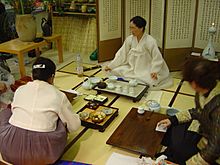
The first historical record of tea in Korea is from 661 AD. It describes a ceremony where tea was offered to the spirit of King Suro, who founded the Geumgwan Gaya Kingdom. Records from the Goryeo dynasty (918–1392) show that tea was offered in Buddhist temples to honor respected monks. During the Joseon Dynasty (1392–1910), the royal family and nobles used tea for simple ceremonies. The "Day Tea Rite" was a common daytime ceremony, while the "Special Tea Rite" was for important events. By the end of the Joseon Dynasty, ordinary people also started using tea for ceremonies, following Chinese traditions.
Early teas used in Korean tea ceremonies were often heavily pressed cakes of black tea, similar to aged Pu'er tea from China. However, Buddhist monks brought tea plants to Korea, leading to more delicate teas and the Korean tea ceremony. Green tea, like "Jakseol" or "Jungno," is most often served today. Other teas, such as "Byeoksoryeong" or "Ujeon," as well as native chrysanthemum tea, persimmon leaf tea, or mugwort tea, might be served at different times of the year.
Tea's Journey Around the World
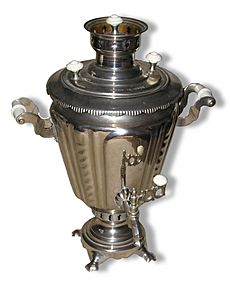
One of the earliest mentions of tea in Western writings is from an Arabian traveler. He said that after 879 AD, the main sources of money in Canton (China) were taxes on salt and tea. Marco Polo wrote that a Chinese finance minister was removed from his job in 1285 for raising tea taxes too much. In 1557, Portugal set up a trading port in Macau. News of the Chinese drink "chá" spread quickly, but it's not clear if they brought any tea samples home.
In the early 1600s, a ship from the Dutch East India Company brought the first green tea leaves from China to Amsterdam. Tea was known in France by 1636 and was briefly popular in Paris around 1648. The history of tea in Russia also goes back to the 1600s. China first offered tea as a gift to Czar Michael I in 1618. The Russian ambassador tried it but didn't like it, delaying tea's arrival in Russia by 50 years. By 1689, tea was regularly brought from China to Russia by caravans of hundreds of camels. This year-long journey made tea a very valuable item. Tea appeared in German pharmacies by 1657 but didn't become very popular there, except in coastal areas like East Frisia. Tea first appeared publicly in England in the 1650s, introduced through coffeehouses. From there, it spread to British colonies in America and other places.
Portugal and Italy's First Taste
Tea was first introduced to Europe by Italian traveler Giovanni Battista Ramusio. In 1555, he published Voyages and Travels, which included the first European mention of tea. He called it "Chai Catai," based on reports from places like Yemen and Somalia.
Portuguese priests and merchants first encountered tea in China in the 1500s, calling it chá. The first Portuguese ships reached China in 1516. In 1560, Portuguese missionary Gaspar da Cruz wrote the first Portuguese account of Chinese tea. In 1565, Portuguese missionary Louis Almeida published the first European account of tea in Japan.
Tea in India
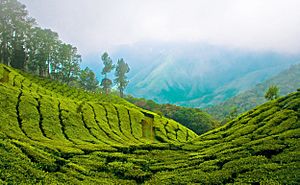
Commercial tea production was first started in India by the British. They wanted to break China's control over the tea trade. The British used Chinese tea seeds and Chinese planting methods. They started a tea industry by offering land in Assam to any European who would grow tea for export. At first, only Indians who adopted British customs drank tea. It wasn't until the 1950s that tea became widely popular in India, thanks to a successful advertising campaign by the India Tea Board.
Before the British, the tea plant might have been used for medicine in India. Some people mention the Sanjeevani plant as an early reference to tea use in India. However, studies show that Sanjeevani is a different plant. The Singpho and Khamti tribes say they have been drinking tea since the 1100s. But large-scale tea production in India only began when the British East India Company arrived. They turned huge areas of land into tea farms.
The Chinese type of tea plant is used for Sikkim, Darjeeling tea, and Kangra tea. The Assam variety, which grows naturally in Assam, was used everywhere else. The British started commercial tea plantations in India and in Ceylon (now Sri Lanka). "In 1824, tea plants were found in the hills between Burma and Assam. The British started growing tea in India in 1836 and in Ceylon in 1867. They first used seeds from China, but later used seeds from the native Assam plant." For many decades, only black tea was made in India, except in Kangra (now Himachal Pradesh), which made green tea for export to Central Asia.
India was the top tea producer for almost a century, but China took over that spot in the 2000s. Indian tea companies have bought many famous foreign tea businesses, including British brands like Lipton, Tetley, Twinings, and Typhoo. Most Indian tea garden owners have focused on selling tea to countries like Europe and Russia. Only a few have built their own brands, such as Makaibari and Dharmsala Tea Company. While India drinks the most tea in the world, each person only drinks about 750 grams per year. Recently, green tea has become very popular in cities. Regions like Kangra, known for their green tea in the past, have seen their green teas become popular again in India.
Tea in Iran
Gilan Province in northern Iran is the main place where Iranian tea is grown. Historically, Lahijan was the first town in Iran to have tea plantations. With its mild weather, good soil, and fresh spring water, Lahijan has the largest area of tea farming in Iran. "Lahijan Spring Tea" is the best quality tea produced in the country. Tea is also grown in other cities of Gilan, like Fuman and Roudsar.
Tea in Taiwan
Taiwan is famous for making oolong tea and green tea, as well as many Western-style teas. Bubble tea, also called "Zhen Zhu Nai Cha," is black tea mixed with sweetened condensed milk and tapioca pearls. For many centuries, Westerners knew the island as Formosa, which means "beautiful island" in Portuguese. Because of this, tea grown in Taiwan is often called "Formosa tea."
Tea in the United Kingdom
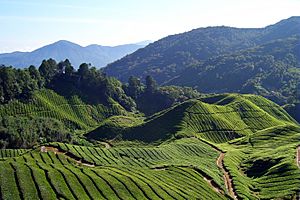
The first mention of tea in English was in a letter from Richard Wickham in 1615. He worked for the East India Company in Japan and asked a merchant in Macao for "the best sort of chaw." Peter Mundy, a traveler, saw tea in Fuji in 1637 and wrote, "chaa—only water with a kind of herb boiled in it." In 1657, Thomas Garway, who sold tobacco and coffee, was the first to sell tea in London at his shop. He charged between 16 and 50 shillings per pound. The same year, tea was listed on a price list in a London coffee house, and the first advertisement for tea appeared in 1658. In 1660, Samuel Pepys wrote in his diary: "I did send for a cup of tee (a China drink) of which I never had drank before." It's likely that early tea imports were smuggled through Amsterdam or brought by sailors.
The marriage of King Charles II to the Portuguese princess Catherine of Braganza in 1662 brought the habit of tea drinking to the royal court. Official tea trade began in 1664 with a small import of just over two pounds for the king. This grew to 24 million pounds per year by 1801.
Regular trade started in Canton (now Guangzhou), China. It was controlled by two groups: the Chinese Cohong (trading companies) and the British East India Company. The Cohong bought tea from 'tea men' who had a complex system to get tea from the mountains. The East India Company brought back many products, and tea was one of the most successful. At first, tea was promoted as a medicine, but by the end of the 1600s, it was drunk for enjoyment. However, it was expensive, so mainly rich people drank it. By the 1700s, tea was traded in large amounts and sold by grocers and tea shops in London.
By the 1720s, black tea became more popular than green tea as its price dropped. British drinkers also started adding sugar and milk to their tea, which was not done in China. By the 1720s, European sea trade with China was mostly about trading silver for tea. As prices kept falling, tea became more and more popular. By 1750, it was the national drink of Britain. A fungus destroyed 95% of coffee production in Ceylon in the 1800s, making tea even more popular. The increase in tea imports and sales from 1690 to 1750 matched the increase in cane sugar imports. This shows that the British were not just drinking tea, but sweet tea.
The Qianlong Emperor of China wrote to King George III in 1793, saying: "Our Celestial Empire possesses all things in great abundance and lacks no product within its borders. There is therefore no need to import the goods of outside barbarians in exchange for our own produce." Tea had to be paid for with silver. Critics of the tea trade worried about Britain losing its wealth due to this silver outflow.
Tea became a very important source of tax money for the British Empire. While Britain also fought wars with China, it began to grow tea in India. After tea plants were secretly brought out of China, plantations were set up in places like Darjeeling, Assam, and Ceylon. The discovery of native tea plants in India was even more important for developing tea production there.
Tea remained a very important part of Britain's global trade. It helped Britain become a powerful global force by the end of the 1700s. Even today, tea is seen worldwide as a symbol of 'Britishness'.
Tea in the Americas
Tea drinking in the United States was greatly affected by the Tea Act and the protests against it during the American Revolution. Tea consumption dropped sharply in America during and after the Revolution. Many Americans switched from tea to coffee, seeing tea drinking as unpatriotic. The American specialty tea market grew four times larger between 1993 and 2008, becoming worth $6.8 billion a year. Specialty tea houses and shops also started appearing during this time.
Canadians were big tea drinkers from the time of British colonization until World War II. Then, like their American neighbors, they started drinking more coffee. In the 1990s, Canadians began to buy more specialty teas instead of coffee.
In South America, tea production in Brazil has strong roots. This is because of the country's Portuguese origins, the large number of Japanese immigrants, and the influence of Argentina's yerba mate culture. Brazil had a big tea production until the 1980s, but it has become smaller in recent decades.
Tea in Australia
The Aboriginal Australians used to drink a drink made from a plant called leptospermum. When Captain Cook arrived in Australia, he saw the Aboriginal people drinking it and called it tea. Today, that plant is known as the "ti tree."
Tea was brought to Australia through British colonization. In fact, tea was on board the First Fleet in 1788. In 1884, the Cutten brothers started the first commercial tea plantation in Australia in Bingil Bay in northern Queensland. This became Nerada Tea. In 1883, Alfred Bushell opened the first tea shop in Australia in Queensland. In 1899, Bushell's sons moved the business to Sydney and started selling tea commercially, founding Australia's first commercial tea seller, Bushell's Company.
In 2000, Australia consumed 14,000 tonnes of tea each year. Tea production in Australia is still very small. It is mainly in northern New South Wales and Queensland. Most tea made in Australia is black tea, but small amounts of green tea are produced in the Alpine Valleys region of Victoria.
Tea in Sri Lanka
Sri Lanka is known for its high-quality tea. It is the fourth biggest tea-producing country globally, after China, India, and Kenya. Sri Lanka produces 9% of the world's tea. About 187,309 hectares of land are used for growing tea. The plantations started by the British were taken over by the government in the 1960s. But they have since been made private again and are now run by companies that own several tea estates. Ceylon tea is divided into three groups: Upcountry, Mid country, and Low country tea, based on where it is grown.
Tea in Africa
The Somali Ajuran Sultanate had trade ties with Ming Dynasty China in the 1200s and brought many goods, including tea. Africa has greatly increased its tea production in recent decades. Most of this tea is for export to Europe and North America. It is produced on large farms, often owned by tea companies from the countries that buy the tea. Almost all of Africa's tea production is for basic, mass-market teas, processed using the crush, tear, curl method.



